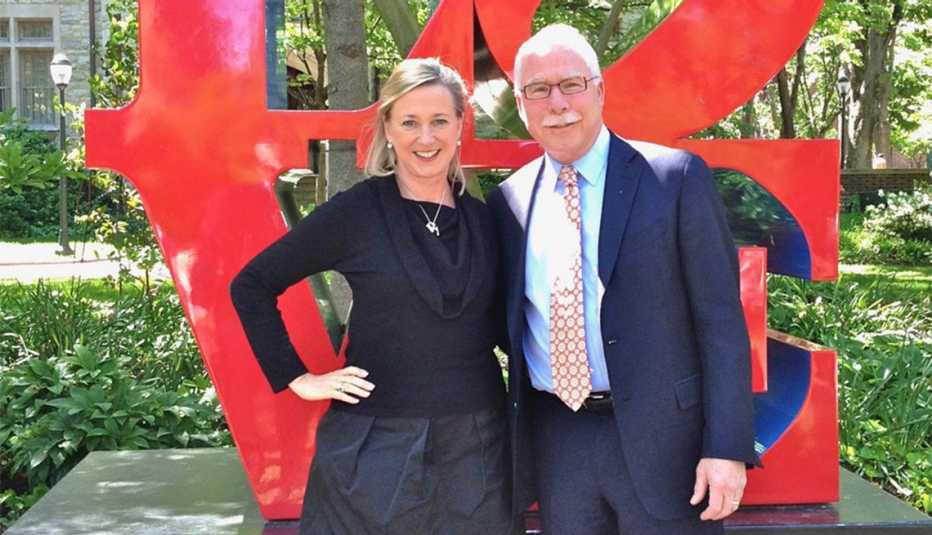Sharing knowledge with others
Schueler has a degree in positive psychology, and her career had been focused on helping people to intentionally build a practice of resilience. Her journey as a sudden caregiver, and the knowledge and advice she had acquired, gave her the idea to help others meet the demands of caregiving with the mindset of well-being. After Joel passed away 18 months following his diagnosis, she immediately began work on her book, The Sudden Caregiver: A Roadmap for Resilient Caregiving.
Approximately 10,000 people in the United States turn 65 years old every day, notes Schueler. For many, that age is a general turning point in the average health of the human body. “The fact that the number of caregivers keeps increasing, along with the idea that we're all going to make this up as we go along, was crazy to me,” Schueler says.
Everything she was reading about caregiving kept talking about how hard it was, and yet she had a theory, based on her own experience, that two opposing things could both be true when it came to caregiving. It was not an either/or. “What I realized through my own journey was that caregiving is difficult, physically demanding, draining and hard — and yet it is also a source of well-being.” When she thought back to the moments when she was caring for her husband, she realized that during much of that time, she felt closer to him.
Schueler began to talk to caregivers about their experiences and ask questions such as: Are your relationships stronger? Do you have more engagement? What are you proud of concerning your caregiving role? She began to evoke positive emotions from the people she was interviewing, and that led her to think about the ways in which we can all choose to reframe a narrative or try to visualize good times and moments ahead.
She developed the acronym “CARE” to describe the different cycles of caregiving. It stands for “Crisis, As Normal as Possible, Resolution and Evolution. “The very simple concept of trying to keep things “as normal as possible” particularly struck me as an important nugget. Providing caregiving for someone to a certain end (or over a long period of time) is a journey punctuated with crises and then periods of normalcy. Resilience is built by anticipating that things will go upside down from time to time, but by actually living in the in-between. That mindset is a huge step forward in mental wellness for both the caregiver and recipient.
Schueler's book outlines the road map essentials that form a continuous circle for caregivers as they move through all aspects of their journey. Like any muscle, this work takes intention and practice. Her pathways to caregiver well-being consist of these steps: Map your journey (set goals and make hopeful plans), assume the position (be proactive), create your care team (include only trustworthy doers), count your blessings (practice gratitude), take care of you (find ways to prioritize your own health) and build resilience (seek the silver lining).
Douglas Noordsy, M.D., director of lifestyle psychiatry at Stanford University School of Medicine, studies the importance of lifestyle changes in overall physical and mental well-being. “Caregivers often become so focused on caring for their loved one that they sacrifice their own needs and self-care, leading to burnout and depression,” he says. “It's essential for people to balance their caregiving with regular exercise, a Mediterranean-inspired diet emphasizing fruits and vegetables, stress management techniques such as mindfulness or yoga, seven to nine hours of quality sleep nightly and supportive social relationships. This may require supports to allow the individual to take time off from caregiving in order to nurture themselves and ensure their mental health and longevity.”
How to Build Caregiving Resilience
Tips gleaned from Schueler's book:
Information at your fingertips is power. While much of the world finds info on the internet, there is no substitute for having a ready piece of paper in front of you and the ability to flip through a binder organized with all the essential information on schedules, medication, important contacts and more.
Evaluate your level of social support. Identify who in your social network can help keep you sane at times by providing stimulus and laughter, even if it means they need to come to you.
Keep a gratitude journal. Research has shown that writing what you're grateful for each day can help you reframe your outlook. Choose an optimistic narrative, even on a bad day. Being able to say, “But this good thing happened today …” results in more resilience and higher well-being.
Sustain good lifestyle habits and invest in self-care. Get as much sleep as you can, eat healthy foods, limit alcohol and try to get exercise — even a 10-minute walk. Most of all, hang out with the right people. Nobody needs a Debbie Downer in the caregiving mix.
Give yourself mini breaks. Find little moments across the day and the week for a 15- to 30-minute release valve, at the minimum.
Self-determination is an important mindset. Understand that you have more insight and power than you think. Give yourself a pep talk!
Ask for help. We may feel like we are imposing, but most people truly do love to be asked to help out. And that act of giving and receiving can bring us closer to others.






































































